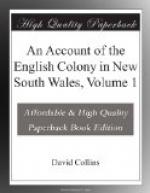Total females and children 354
From the foregoing statement it appears, that not more than one hundred and thirty-six men, composing the fourth class, are employed in carrying on public work, of which number only twenty-eight can be employed (when other works of public necessity do not intervene) in raising grain, etc. without expense to the crown, for the first, third, fourth, and a part of the fifth and sixth classes; making together four hundred and forty-two persons.
Those of the fourth class who labour as carpenters, sawyers, blacksmiths, etc. work from daylight till eight o’clock; from nine till noon; and from two in the afternoon till sun-set; and as long as they do their work properly, they have Fridays and Saturdays to themselves, which they employ in working at their grounds, or in building, etc. for settlers and others who can employ them. As those works are in fact of a private nature, although in the end they become more or less of public utility, the artificers are indulged with the use of government-tools and such materials as can be spared.
Those employed in cultivation, and other incidental labour, for the public benefit, work at all seasons from daylight until one o’clock, which is found much more advisable than dispersing them at the hours for meals, and collecting them again to resume their labour. As very few of this description have any persons to dress their meal, or grind their maize, they have by this management a great part of the day at their own disposal; and from the 21st of September to the 21st of February no public work is done on Saturdays. Those of this description who are industrious employ a great part of their leisure time in cultivating pieces of ground for their own use, or labouring for others.
The second and a part of the fifth and sixth classes, making together three hundred and thirty-one persons, support themselves by the produce of their labour without expense to the crown; as the clothing with which they and the settlers are occasionally furnished from the stores is paid for in grain or stock.
ORDINARY PRICE OF LABOUR
To a convict taken off the stores by an officer or settler, from L5 to L5 per annurn
To a freeman hired by the year, victualled and clothed, from L10 to L12 per annum.
A day’s work for a labourer, with victuals, is 3s; without, 5s
Cutting down and burning off an acre of wood, L2
Cutting down and burning off an acre of weeds, L1 10s
Threshing one bushel of wheat, 10lbs.; equal to 1s 8d.
Other works are in proportion. The mode of payment for labour is various, and depends entirely on the employer’s circumstances; but it is in general made by what arises from the grain or fresh pork put into the stores by settlers, etc.; sometimes (but very rarely) in cash; and often by equal labour, or by produce, which is rated as underneath.




